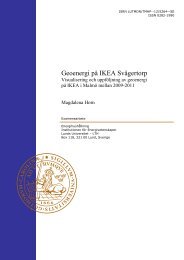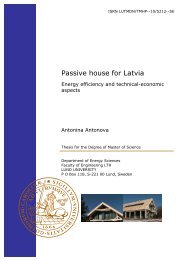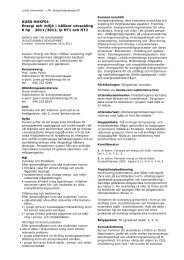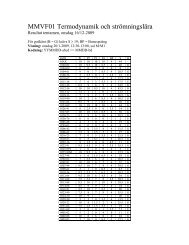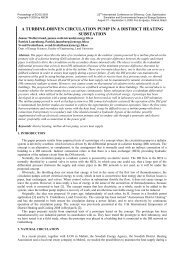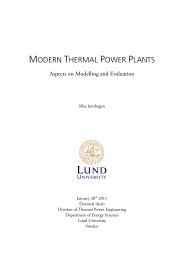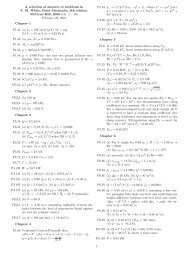Energy Consumption in Tertiary Buildings in Sweden - Case-study
Energy Consumption in Tertiary Buildings in Sweden - Case-study
Energy Consumption in Tertiary Buildings in Sweden - Case-study
You also want an ePaper? Increase the reach of your titles
YUMPU automatically turns print PDFs into web optimized ePapers that Google loves.
Load [kWh/h]<br />
400<br />
350<br />
300<br />
250<br />
200<br />
150<br />
100<br />
50<br />
0<br />
12 13 14 15 16 17 18 19 20 21 22 23 24 1 2 3 4 5 6 7 8 9 10 11<br />
Time [h]<br />
Average October week days<br />
Thursday 20th - Friday 21st<br />
Figure 10: Comparison between the electricity load curve of the week days average <strong>in</strong> October 2011 and the day<br />
of the test<br />
Two ma<strong>in</strong> reasons could expla<strong>in</strong> this result. The first one could be that not<br />
many people followed the <strong>in</strong>structions and they did as any other day, go<strong>in</strong>g home<br />
without turn<strong>in</strong>g off the non-essential appliances. The second, and probably the most<br />
important, is that the measures taken by AH are too rough. There is only one meter for<br />
the whole build<strong>in</strong>g, except for Max-lab, a big laboratory located <strong>in</strong> the build<strong>in</strong>g but<br />
completely <strong>in</strong>dependent. Therefore any action <strong>in</strong> users’ habits can be hardly<br />
appreciated <strong>in</strong> the meter measurements, s<strong>in</strong>ce that only represent a small part of the<br />
total build<strong>in</strong>g load as it has been expla<strong>in</strong>ed before.<br />
Measures taken and evaluation of effectiveness<br />
No measures to change consumers’ behaviour were possible to be taken. This<br />
goal could not be reached and the Thesis had to be focused on the <strong>study</strong> of how<br />
energy is used by employees. The ma<strong>in</strong> reason was the impossibility to analyse the<br />
changes <strong>in</strong> the load curve. As it has been expla<strong>in</strong>ed, the measures taken by AH are too<br />
rough to see significant differences <strong>in</strong> the load curve when consumers’ change their<br />
habits. Any difference <strong>in</strong> a load curve before and after apply<strong>in</strong>g a measure <strong>in</strong> this field<br />
couldn’t have been considered as a result of the measure itself. Hence, with the<br />
current system of measures, with one meter for the whole build<strong>in</strong>g, it is not possible to<br />
perform a <strong>study</strong> on the effectiveness of behaviour change measures on the use of<br />
energy.<br />
20




